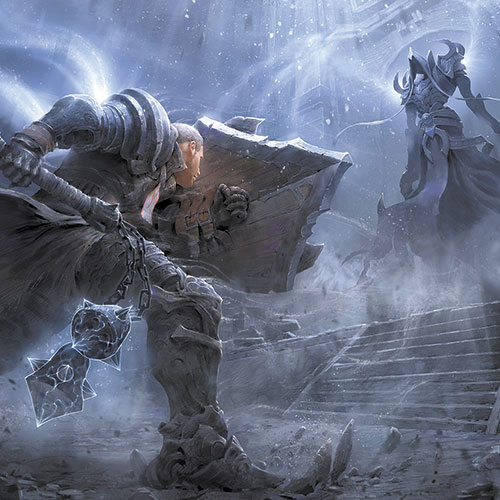To hell and back again in ‘Diablo III’ expansion

By Daniel Tack | Game Informer Magazine (MCT)
“Diablo III: Reaper of Souls”
Platform: PC
Genre: 1 to 4-player Action/Role-Playing
Publisher/Developer: Blizzard Entertainment
ESRB: M, for Mature
“Diablo III’s Reaper of Souls” expansion is one of the most significant turnarounds in gaming. Out of the ashes of a boring, auction house-centric grind comes a dynamic and addictive system that encourages grouping and rewards players with continual upgrades and challenges. Almost every facet that players rightly attacked in the original game has been refined and revamped, transforming the title into an enjoyable action/RPG experience.
The new Crusader class, abilities, levels, act, and final boss are only the surface-level selling points of “Reaper of Souls.” If you’re expecting a scintillating story to go along with the new content, don’t. It’s the same hackneyed fare that’s almost comical at this point. Based on the time I spent leveling a Crusader to 70, fans of “Diablo II’s Paladin” will find plenty of hammer-hurling holy fun. Act 5 has more content than other acts — including many optional areas — but pushing through it doesn’t take long. The new final boss fight is slightly more difficult than the iconic red villain of the franchise, but it’s nothing particularly special or interesting.
They are nothing compared to the massive replayability and dynamic-dungeon delving that bounties, rifts and Adventure mode (unlocked by completing act 5) provide. The real revolution comes not with any completely new content, but with the way recycling content is handled.
Adventure mode breaks things up to keep the game fresh. Players have always been able to plod linearly through areas and acts, but Adventure mode breaks up content into manageable slices and provides additional rewards. Instead of moving from point A to B to C ad nauseam, players are presented with varied tasks in each act that can be completed in any order to unlock treasure caches and items to access the Nephalem Rifts.
The loot-centric action/RPG is always going to be battling against repetition and tedium, and these methods of serving up gameplay are most welcome. Players with a few minutes can crank out some bounties, while players with more time can jump in with friends and tear into Rifts. Once I moved on to these experiences, I didn’t look back to the main campaign for gameplay.
Rifts are randomized areas that can have a variety of monster types and tile sets from throughout the game, and are loaded with elite mobs and bosses. Rifts are “the endgame,” and while they can be completed solo, they shine in a group setting. When the monster-kill meter inside the Rift is full, the boss spawns and players bring it down for a glut of loot, gold, and experience. Rifts can take a while to complete as solo player, and are at their best with a group of three or four. Playing with a team increases your magic find, and you are able to take on harder difficulties for additional chances at legendary drops. Players can even trade gear for a limited time, so if you don’t need a particular legendary, you can pass it on to a friend. You need to farm items to access these Rifts, and since one entry fee can get a whole group inside, teaming up reduces the hassle for everyone.
I’ve completed 100 bounties and a handful of Torment 1 difficulty Rift runs with friends, and they are more interesting and rewarding than anything in the core game.
Many changes that went live recently are integral to the “Reaper of Souls” experience. With the Loot 2.0 and paragon level changes, players find their inventories overflowing with usable gear, so making builds designed around certain abilities is easier. Paragon leveling provides small bonuses like health, move speed and stats to let players continue to grow forever after the level cap. The bonuses from each paragon level are small, but they add up and bring an element to the game that lets players continue to progress outside of the gear grind. In the core version of “Diablo III,” a player could go months without finding a legendary item — or be forced to purchase gear from the auction house to advance. The orange glow is still special, but now you see it regularly during gameplay.
Along with all the new loot, players have access to more options involving that loot. Crafting has been redone, and you can track down a plethora of legendary recipes. These special recipes require specific components that drop off rare monsters. You acquire some of these naturally if you choose to engage in Adventure mode, as the missions often involve tracking down these named spawns. During Act 5, players unlock the Mystic NPC. Did that awesome item drop but it had a stat that didn’t mesh well with your build? The Mystic allows players to reroll certain item characteristics, providing a new optimization route and resource sink.
With a staggering revamp that touched upon almost all aspects of the game and modes that keep things interesting, “Reaper of Souls” isn’t so much an expansion as it is a completely new game.











